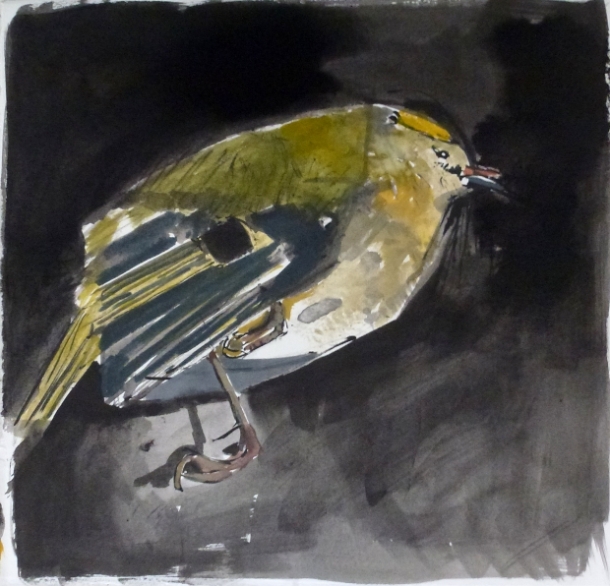Whilst I was in Ullapool six weeks ago an unfortunate thing happened. A beautiful, perfectly-formed female goldcrest flew into a large window in my host’s house. Sad as this was, it gave me the opportunity to really study this bird in close detail and I was able to make some drawings from it (I brought it back in a honey jar where it still is in my freezer!).
This incident made me think about what birds are flying past my window on a regular basis that I don’t see – my host marvelled that this little goldcrest had been flying past his house. One of the joys of engaging with nature is realising there is so much more to see and learn; it is just a case of tuning in and training your skills of observation. It is heartening – and exciting – to think what birds might be flying past your window, not to forget the mammals which might be scurrying past or the insects which are floating by.
This photograph I took of the dead gold crest shows its tongue sticking out and looking like its made of coloured glass. I was astonished by its rigid shape, having always assumed birds would have similar tongues to us. A bit of research led me to a copy of Tim Birkhead’s Bird Sense book which is stuffed full of information about how birds sense the world. From a cursory read of the chapter on taste, it seems that bird’s taste sensations and the function of their tongues are very different to humans. Here is an extract from this fascinating book to whet your appetites:
‘We also know that hummingbirds can taste differences in the amount of sugar in nectar, that fruit-eating birds can distinguish between ripe and unripe fruit – on the basis of its sugar content – and that wading birds such as sandpipers can taste the presence of worms in wet sand.’
I love the idea of birds being able to ‘taste the presence of worms’! Even if you are not into birds I would recommend reading this book as it ponders our concept of human senses alongside that of birds.
The dead goldcrest also made me think about how artists have always been drawn to depicting and studying dead birds – here are a few examples:
I love this sheet of drawings by Charles Tunnicliffe of a Green Woodpecker. Over the course of his career Tunnicliffe made many detailed studies from dead birds.
This beautiful drawing by Lucien Freud of a dead, juvenile puffin is very poignant – the care and attention to detail suggests the strength of feeling felt by the artist for his subject matter.
A wonderful dead crow from Leonard Baskin – great marks describing the complex tangle of feathers.
A beautiful etching by American artist Kiki Smith and finally…
Another of mine. Next post – my new goldcrest screen print as it develops (this one is alive)!







Hi Kittie, I discovered your blog today because yesterday I bought a copy of the book ‘ghosts of gone birds’, which i am finding fascinating and after seeing your beautiful work in there, searched for you on the web to find this great blog and website. Thank you very much for sharing your work and your thoughts, it is very inspiring! Laura
Hi Laura, many thanks for taking the time to comment, I’m glad to hear you’ve enjoyed my work and delighted you found it through the beautiful Ghosts of Gone Birds book…Best wishes, Kittie